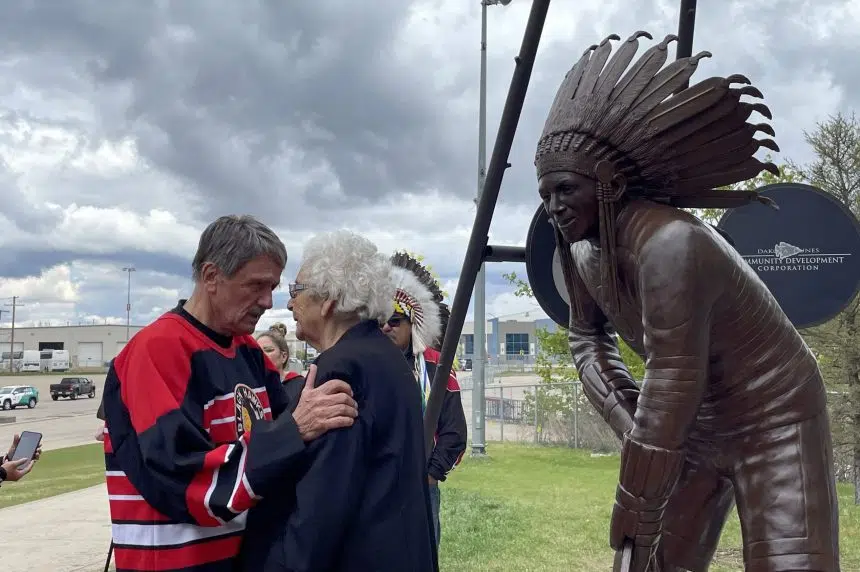Hundreds of people gathered outside SaskTel Centre in Saskatoon on Wednesday to commemorate the second Fred Sasakamoose Day with a special reveal.
There wasn’t much sun in the sky to glisten off the 25-year-old bronze-cast face of Sasakamoose, but faces were lit by smiles as the statue was unveiled. The Saskatchewan hockey legend played 11 games in the NHL, making him one of the first Canadian Indigenous hockey players to make the league, and the first with treaty status.
Sasakamoose died in 2020 from COVID-19.
His son, Neil Sasakamoose, was present Wednesday for the reveal of his father’s likeness, alongside Neil’s mother, Loretta, and two of his uncles.
Neil said seeing the statue brought bittersweet feelings, relief, and a feeling of being overwhelmed.
“You’re memorializing someone you wish was here,” he shared.
Neil said he’s grateful the statue — located at the entrance of SaskTel Centre — will be seen by many people in the coming years, and was glad his mother could attend the unveiling of the statue.
While the statue will help preserve and share his father’s legacy, Neil also called it a “special place” for himself.
“It’s a place for me. When no one’s around, I get to come and visit my dad … come say ‘hi’ to him and tell him we’re all OK,” Neil said.
Many people shared memories of Fred Sasakamoose and his lasting legacy in hockey, Saskatchewan, and Indigenous communities.
Saskatoon Mayor Charlie Clark and Saskatoon Tribal Council Chief Mark Arcand both spoke at the unveiling, as well as Glen McCallum with the Metis Nation of Saskatchewan, Deputy Minister Christiane Fox with Indigenous Services Canada and Chief Larry Ahenakew with Battlefords Agency Tribal Chiefs.
Rob Knesaurek spoke at the event on behalf of the NHL, and attendees also heard from Indigenous hockey player Brigette Lacquette. Troy Davies spoke on behalf of Synergy 8, the group responsible for making the Sasakamoose statue a reality.
Neil said his father’s legacy goes beyond the player who laced up and competed on the ice. Fred Sasakamoose didn’t believe in racism or hate and “only had love” in his heart, Neil remembered.
Neil also believes his father’s experiences in residential schools are meant to live on, so more people can come to understand the impact they had on Indigenous families and continue to have on younger generations.
“He wanted to make sure that people understand what that generation went through and what people like me went through,” Neil explained.
For the next generation of Indigenous athletes looking up to his father’s legacy, Neil offered a simple message: “Always remember where you came from.”
Neil said his father could have chosen to move to a bigger city or stay in the United States to enjoy his success as an athlete, but instead he never forgot or left his home community and the people who helped get him where he was.
“It’s designed for Indigenous people to be proud,” Neil reflected on the statue’s meaning.













